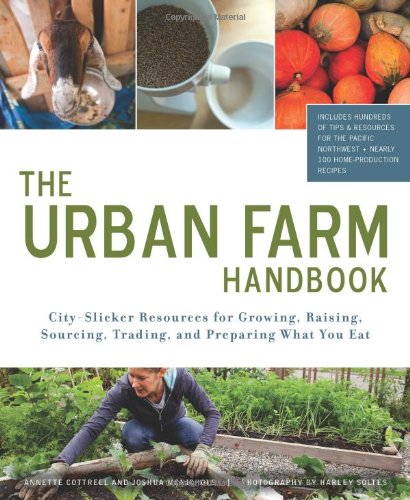 The Urban Farm Handbook, Annette Cottrell and Joshua McNichols (Mountaineers Books, 2011)
The Urban Farm Handbook, Annette Cottrell and Joshua McNichols (Mountaineers Books, 2011)
Are we having a spate of “mid-life food crises” or are folks in their late 30s and early 40s simply realizing that the words “supermarket” and “good food” don’t seem to belong in the same sentence anymore?
Annette Cottrell – self-avowed “extreme gardener” – and Joshua McNichols turned their love of whole, minimally processed, naturally grown food into both a passion and a book. The Urban Farm Handbook is a 21st Century Whole Earth Catalog of food and gardening, for “city slickers” instead of “off-the-grid, back-to-earthers.” The Whole Earth Catalog, first published in 1968, predates the two by several years, and yet the Catalog embraced science, intellectual endeavor, and new technology as well as old.
Annette and Joshua began writing their book several years ago and shopped the proposal around for a while with no real luck. It was a newspaper interview with Annette that caught the attention of their publisher and, as they say, the rest is history.
Recently, Joshua and I met in a local coffee shop to watch the rain clear into a beautiful fall morning and talk about food. Trained as an architect but now a journalist, Joshua is no back-to-earther. He’s not about to give up his bread machine and he truly understands the value of an electric juicer.
The Handbook is divided into four major sections representing the four seasons and it is a great resource for those wanting to grind their own grain, raise backyard chickens and goats, maximize their garden production on a small urban lot, and preserve their bounty.
Gardening is not a solitary occupation, it also is a way to bring neighbors together and build community. Whether you are interested in a buying club or organizing neighborhood “barter fairs,” the Handbook has helpful advice.
The very first chapter starts with grain – the staff of life. You may not want to jump directly into buying a grain mill, sourcing local grains, and grinding your own flour, but you can make changes that will bring more local grains into your life.
Buy organic bread made in a local bakery from local grains. Amanda Irving, Tall Grass Bakery, makes bread out of spelt that is leavened with wild yeast. René Featherstone, who delivers the flour from his farm – Lentz Spelt Farm (about 200 miles away) – grows organic spelt, emmer and einkorn.
Buy whole grain flour and bake your own bread. Shop at your favorite natural food co-op or small natural food market and buy locally milled organic whole grain flour and try your hand. With practice you’ll find it’s both easy and economical. Small mills, like Kevin Christenson’s Fairhaven Organic Flour Mill, are turning up more and more often. At least 60% of the grain Fairhaven grinds is grown in Washington and most of the wheat is from Washington.
Sprinkled throughout the book are producer profiles, stories about the folks who make good food possible for the rest of us. People like René Featherstone, who looks almost biblical with his long grey beard; “Skeeter” (Michael Pilarski), who is still farming at 84; Ken and Rebecca Reid, beekeepers; orchardist Wade Bennett; and many more.
GoodFood World gives The Urban Farm Handbook two sticky thumbs up. (It was the recipe for apple and quince jelly that did it!)


This book should be on everyone’s shelf who cares about the environment. It’s totally necessary that we all find ways to live closer to the earth, no matter where we live. The truth is most of us cannot pick up and relocate to a rural place, we’d probably not survive. So learning how to do it where you live is the key.
Michael Kuenhert
Save The Farm Movie
http://www.cinemalibrestudio.com/savethefarm/
In the 11th hour and in the middle of south central L.A., they fought to save the farm.